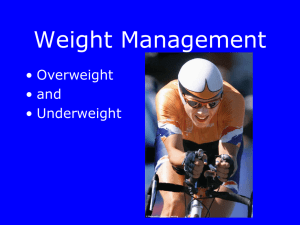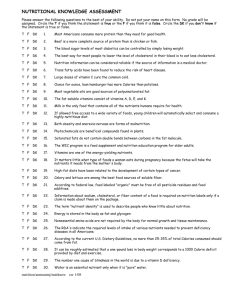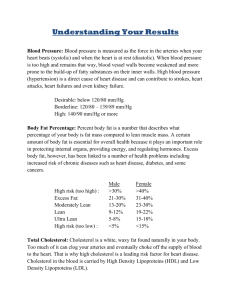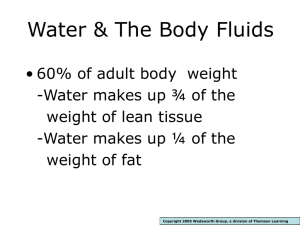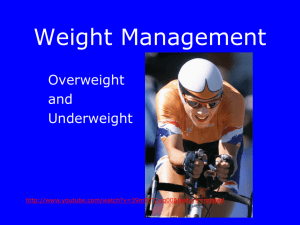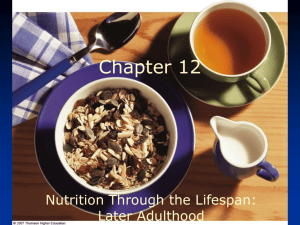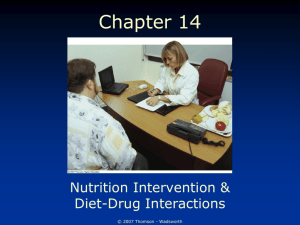Cardiovascular Disease, Hypertension, Cancer
advertisement
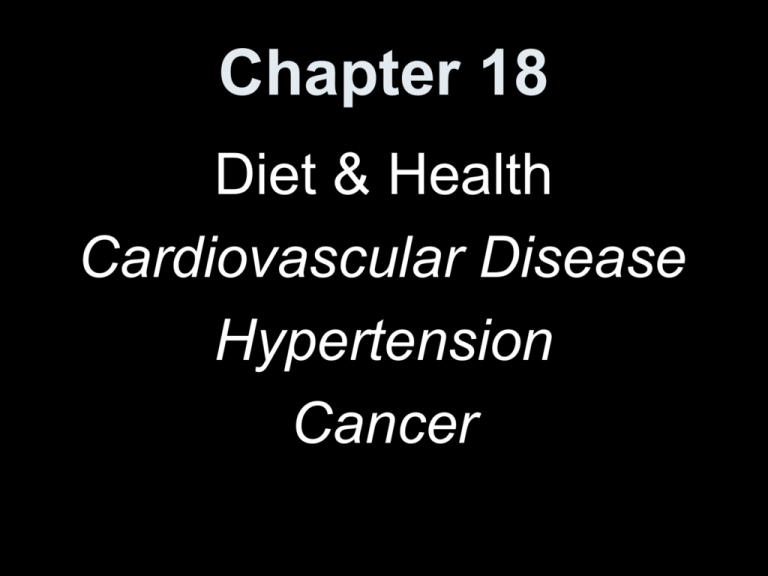
Chapter 18 Diet & Health Cardiovascular Disease Hypertension Cancer Nutrition And Chronic Disease Leading causes of death in the U.S. Copyright 2005 Wadsworth Group, a division of Thomson Learning Nutrition And Chronic Disease Copyright 2005 Wadsworth Group, a division of Thomson Learning Cardiovascular Disease • Heart/blood vessel disease, includes: –Coronary heart disease (CHD)most common form of CVD • Atherosclerosis of the coronary arteries –Hypertension (HTN) –Heart failure Atherosclerosis • “Hardening of the arteries”- begins as accumulation of fatty streaks along the inner arterial walls that gradually enlarge & harden • Fatty plaques in artery walls caused by: 1. Accumulation of lipids 2. Inflammatory response in response to tissue damage from high LDL cholesterol, HTN, toxins from cigarette smoking, elevated homocysteine, infections 3. Platelets forming blood clots that cause a thrombosis or embolism Atherosclerosis • Narrowing/Obstruction of blood flow results in: 1. High blood pressure – needed to deliver blood to the tissues 2. High C-reactive protein – marker of inflammation 3. Angina – pain & pressure when heart muscle deprived of oxygen 4. Heart attack – area of the heart muscle dies when blood flow is cut off 5. Stroke or transient ischemic attack – restricted blood flow to the brain Copyright 2005 Wadsworth Group, a division of Thomson Learning Risk Factors For CHD Copyright 2005 Wadsworth Group, a division of Thomson Learning Diet Strategies to Prevent & Treat CHD • Four main goals: 1. A healthy eating pattern 2. A healthy body weight 3. A desirable blood cholesterol and lipoprotein profile 4. A desirable blood pressure A Healthy Eating Pattern • Consume a variety of fruits, vegetables, and whole grain products to increase antioxidants, folate (to decrease homocysteine levels) and viscous fiber to 20-30 gm/day • Include fat-free and low fat milk products, fish, legumes, poultry, and lean meats A Healthy Body Weight • Balance energy intake with energy needs reduce total fat intake; a diet high in fat is generally high in calories • Achieve a level of physical activity that either balances with energy needs (for weight maintenance) or exceeds energy needs (for weight reduction) A Desirable Blood Cholesterol and Lipoprotein Profile • Decrease total fat to 25-35% of total calories • Decrease saturated fat intake to <10% of total calories to lower LDL; dietary sources include meat, poultry, butter, dairy products, coconut oil, palm oil, cocoa butter, hydrogenated oils; solid at room temperature A Desirable Blood Cholesterol and Lipoprotein Profile • Replace saturated fat with unsaturated fatty acids; liquid at room temperature Monounsaturated Fatty Acids – canola & olive oils, avocados, peanuts, pecans; Recommendation <20% of total calories to lower LDL & raise HDL Polyunsaturated Fatty Acids – corn, sunflower, safflower & soybean oils Recommendation <10% of total calories Omega-3 fatty acids – fish & flaxseed oil lowers LDL & HDL A Desirable Blood Cholesterol and Lipoprotein Profile • Limit trans-fatty acids – hydrogenated unsaturated fats (vegetable oils) raise LDL; Dietary sources include margarine, baked goods, shortening, peanut butter • Limit cholesterol intake to <250 mg/day; Dietary sources include egg yolks, organ & high-fat meats, butterfat A Desirable Blood Cholesterol and Lipoprotein Profile • Moderate alcohol intake, if at all; may be cardioprotective by raising HDL & preventing blood clots but may raise triglycerides • Phytosterols-compete with cholesterol absorption; added to margarines • Physical activity • Smoking cessation • Drug therapy Copyright 2005 Wadsworth Group, a division of Thomson Learning A Desirable Blood Pressure • Cause of high blood pressure unknown although kidneys play a role • Risk factors: 1. Age – increases after age 50 2. Heredity 3. Obesity/Diabetes 4. Race – higher among African-Americans 5.Smoking 6.Alcohol 7.High blood lipids 8.Gender A Desirable Blood Pressure • High blood pressure can result in: 1. Heart strain -> heart failure 2. Aneurysm 3. Accelerates atherosclerosis 4. Kidney failure Recommendations for Reducing Hypertension Risk • Limit the intake of sodium to <2400 mg/day; limit table salt and salted, smoked, canned, and highly processed foods • Limit alcohol consumption (no more than 1 drink/day for women and 2 drinks/day for men) • Maintain a healthy body weight, especially abdominal fat • Increase physical activity Recommendations for Reducing Hypertension Risk • Increase potassium, calcium, and magnesium intake DASH diet – Dietary Approaches to Stop Hypertension; increase fruits, vegetables, legumes, nonfat dairy products along with low fat, low saturated fat, low cholesterol diet Potassium especially important if on potassium wasting diuretic; 8-10 servings fruits & vegetables/day Copyright 2005 Wadsworth Group, a division of Thomson Learning Cancer • Cancer is not a single disorder but all develop from mutations in the genes that regulate cell division • Tumor (neoplasm) – abnormal mass of cells with no function – Malignant tumors multiply out of control and threaten health – Benign tumors stop growing or can be surgically removed How Cancer Develops • Genetic factors – inherited predisposition • Immune factors – tumor cells not recognized as foreign • Environmental factors – exposure to radiation and sun, water and air pollution, smoking • Dietary factors - Initiators - Promoters - Antipromoters How Cancer Develops Copyright 2005 Wadsworth Group, a division of Thomson Learning Cancer Initiators • Factors that cause mutations that give rise to cancer – Alcohol – Pesticides – Grilled food creates polycyclic aromatic hydrocarbons – Red meat – Fried foods containing acrylamide Cancer Promoters • Factors that favor the development of cancer once it has started –High saturated and trans-fatty acid diets –High calorie diets Cancer Antipromoters • Factors that oppose the development of cancer – Omega-3 fatty acids – Fiber – Cruciferous vegetables containing phytochemicals – Antioxidant nutrients – beta-carotene, vitamin C and Vitamin E Recommendations For Reducing Risk • Eat a variety of healthful foods – Emphasize plant sources • Adopt a physically active lifestyle • Maintain a healthful weight throughout life • If you drink alcoholic beverages, limit consumption • Do not smoke or use tobacco in any form Copyright 2005 Wadsworth Group, a division of Thomson Learning Food Guide Pyramid for Disease Prevention Copyright 2005 Wadsworth Group, a division of Thomson Learning



